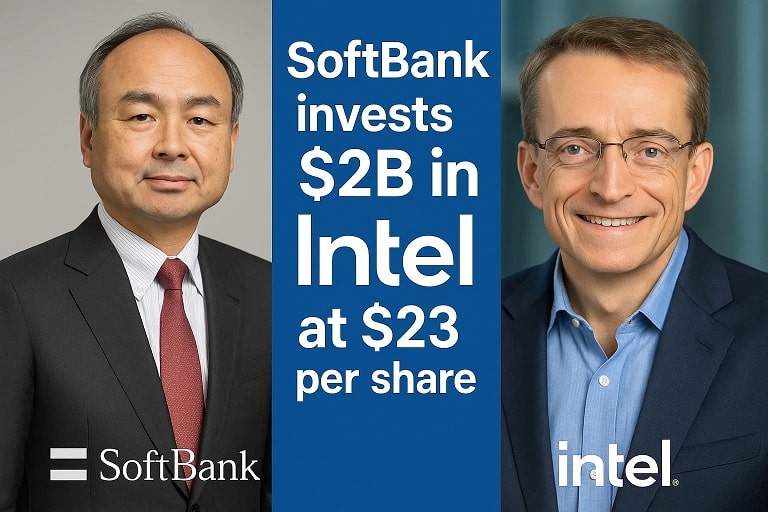SoftBank Invests $2 Billion in Intel at $23 per Share: A Strategic Lifeline for the Chipmaker
On August 18, 2025, SoftBank Group Corp., a Japanese technology investment giant, announced a $2 billion investment in Intel Corporation (Nasdaq: INTC), acquiring approximately 2% of the struggling U.S. chipmaker at $23 per share. This deal, formalized through a securities purchase agreement, marks a significant vote of confidence in Intel’s potential to reclaim its position in the semiconductor industry amid challenges in AI and foundry ambitions. The investment comes as Intel navigates financial losses and competitive pressures, with its stock price reflecting a turbulent journey, as seen in the finance card above. This article provides a detailed analysis of the deal, its context, implications, and supporting data in tables, concluding with answers to frequently asked questions.
Overview of the Investment
SoftBank’s $2 billion investment involves purchasing Intel common stock at $23 per share, a slight discount to the closing price of $23.66 on August 18, 2025. The deal, which makes SoftBank Intel’s sixth-largest shareholder, is structured as a primary issuance of new shares, injecting fresh capital into Intel. Following the announcement, Intel’s shares surged 5.6-6% in after-hours trading, reaching around $25, while SoftBank’s shares dropped over 5% in Tokyo trading on August 19, 2025. The investment aligns with SoftBank’s broader strategy to bolster U.S. semiconductor innovation, complementing its stakes in AI leaders like Nvidia and Arm, and its role in the $500 billion Stargate AI infrastructure project.
Intel, under new CEO Lip-Bu Tan since March 2025, is attempting a turnaround after a $18.8 billion loss in 2024, its first annual loss since 1986. The company has struggled to compete in the AI chip market, dominated by Nvidia, and its foundry business, aimed at manufacturing chips for external clients, has yet to secure major customers despite significant investments. SoftBank’s capital injection provides a financial lifeline and strategic support for Intel’s ambitions in advanced manufacturing and AI.
Historical Context: Intel’s Struggles and SoftBank’s Vision
Intel, once a titan of Silicon Valley, has faced significant challenges over the past decade. Its dominance in PCs and servers has eroded as competitors like AMD and TSMC gained market share, and Nvidia capitalized on the AI boom. Intel’s stock, as shown in the finance card above, closed at $23.66 on August 18, 2025, down from a year-high of $27.55 and a 2003 peak of $32.20. A 60% value drop in 2024 underscored its struggles, driven by management missteps and failure to adapt to AI-driven demand. The ousting of former CEO Pat Gelsinger in December 2024, followed by Tan’s appointment, marked a pivot toward stabilizing the company and scaling back ambitious foundry plans.
SoftBank, led by Masayoshi Son, has a history of bold tech investments, including a $30 billion stake in OpenAI and a $6.5 billion acquisition of Ampere Computing in 2025. Its Intel investment reflects a dual strategy: a financial bet on an undervalued asset (Intel’s $107.5 billion market cap is below its $109 billion asset value) and a strategic move to support U.S. semiconductor leadership amid geopolitical tensions and tariffs on imported chips.
Detailed Breakdown of the Deal
Financial Structure
- Investment Amount: $2 billion for a ~2% stake in Intel.
- Share Price: $23 per share, a discount from the $23.66 closing price on August 18, 2025.
- Share Issuance: Primary issuance of new common stock, providing fresh capital.
- Shareholder Impact: SoftBank becomes Intel’s sixth-largest shareholder, per LSEG data.
- Market Reaction: Intel shares rose 5.6-6% to ~$25 in after-hours trading; SoftBank shares fell over 5% in Tokyo.
Strategic Objectives
- Intel’s Turnaround: The capital supports Intel’s efforts to stabilize finances and advance its foundry and AI chip initiatives.
- SoftBank’s Vision: Strengthens its portfolio in AI and semiconductors, complementing stakes in Nvidia, Arm, and Stargate.
- U.S. Focus: Aligns with SoftBank’s commitment to U.S. tech leadership, amid Trump administration discussions of a potential 10% government stake in Intel ($10.5 billion).
Key Stakeholders
- Masayoshi Son: SoftBank’s CEO emphasized Intel’s critical role in U.S. semiconductor expansion.
- Lip-Bu Tan: Intel’s CEO, navigating controversies over alleged China ties, welcomed the deal as a sign of shared commitment to U.S. innovation.
- Investors: The deal does not include a board seat or chip purchase commitments, focusing purely on equity.
In-Depth Analysis: Trends and Implications
Strategic Importance
SoftBank’s investment is a lifeline for Intel, which reported a $18.8 billion loss in 2024 and faces challenges in its foundry business, costing $20-30 billion per facility. The $2 billion, while modest compared to foundry costs, boosts liquidity and signals confidence to investors. Intel’s role as the only U.S. company capable of advanced chip manufacturing makes it a national security priority, as evidenced by White House discussions for a potential $10.5 billion stake.
Market and Industry Trends
- AI and Semiconductors: Intel’s lag in AI chips, where Nvidia dominates, highlights the urgency of innovation. SoftBank’s investment may accelerate Intel’s AI roadmap.
- U.S. Manufacturing Push: The CHIPS Act ($280 billion) and Trump’s tariffs on foreign chips underscore domestic production needs. Intel’s Ohio fab, delayed by funding issues, could benefit.
- Corporate Investments: SoftBank joins firms like ETHZilla in pivoting to high-growth tech assets, reflecting a trend of diversifying portfolios with semiconductors and AI.
Challenges
- Financial Strain: Intel’s 2024 loss and ongoing foundry investments strain its balance sheet.
- Competition: AMD, TSMC, and Nvidia outpace Intel in key markets.
- Dilution: New share issuance may dilute existing shareholders, though the 5.6% stock surge mitigates concerns.
- Geopolitical Risks: Allegations of Tan’s China ties and potential U.S. tariffs add complexity.
Future Projections
Intel aims to secure major foundry customers by 2026, with SoftBank’s capital supporting R&D and capacity expansion. If successful, Intel’s stock could recover toward its year-high of $27.55. SoftBank may increase its stake, aligning with its $500 billion Stargate project. However, failure to secure foundry orders or navigate regulatory scrutiny could hinder progress.
Table: Financial Snapshot of the Deal (August 2025)
Metric | Value | Details |
|---|---|---|
Investment Amount | $2B | ~2% stake in Intel |
Share Price | $23 | Discount from $23.66 close |
Shares Issued | ~87M | Primary issuance, new capital |
Intel Market Cap | $107.5B | Below $109B asset value |
Stock Reaction | +5.6-6% | Intel surged to ~$25 in after-hours |
SoftBank Shares | -5% | Declined in Tokyo trading |
Table: Intel Stock Performance (2025, from Finance Card Above)
Period | Price (USD) | Change |
|---|---|---|
Current (Aug 18) | 23.66 | -3.67% from $24.56 (prev. close) |
1-Month High | 24.93 | August 14, 2025 |
1-Month Low | 19.28 | August 1, 2025 |
1-Year High | 27.55 | Within 2025 |
1-Year Low | 17.665 | Within 2025 |
2024 Average | 20.01 | Yearly decline of ~60% |
FAQs
What is the purpose of SoftBank’s $2 billion investment in Intel?
The investment provides Intel with capital to support its turnaround, focusing on foundry expansion and AI chip development, while aligning with SoftBank’s U.S. tech strategy.
How many shares is SoftBank buying?
At $23 per share, SoftBank is acquiring approximately 87 million shares, representing a ~2% stake in Intel.
Why is Intel struggling?
Intel reported a $18.8 billion loss in 2024, lost AI chip market share to Nvidia, and has yet to secure major foundry customers despite heavy investments.
How did Intel’s stock react?
As shown in the finance card above, Intel’s stock closed at $23.66 on August 18, 2025, and surged 5.6-6% to ~$25 in after-hours trading post-announcement.
Why did SoftBank invest at $23 per share?
The $23 price reflects a slight discount from the $23.66 closing price, making it attractive for SoftBank while providing Intel with immediate capital.
Is this related to U.S. government plans?
No direct connection exists, but the deal follows reports of a potential $10.5 billion government stake in Intel to bolster national security.
Who benefits from the deal?
Intel gains liquidity and credibility, SoftBank secures an undervalued asset, and the U.S. chip industry receives a boost amid global competition.
What are the risks for Intel?
Shareholder dilution, ongoing financial losses, and failure to secure foundry customers could limit the investment’s impact.
How does this fit SoftBank’s strategy?
It complements SoftBank’s AI and semiconductor investments, including OpenAI, Arm, and the Stargate project, focusing on U.S. tech leadership.
What’s next for Intel?
Under CEO Lip-Bu Tan, Intel aims to stabilize finances, secure foundry orders, and advance AI chips, with SoftBank’s capital aiding these efforts by 2026.













